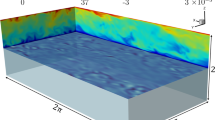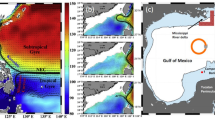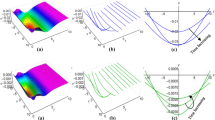Abstract
A theory proposed about 10 years ago claimed that the jovian Great Red Spot (GRS) was a solitary wave vortex (Rossby soliton) kept stationary by counter–streaming zonal winds. We have attempted to verify this soliton theory experimentally. The jovian atmosphere is modelled by a rotating thin parabolic layer of fluid (shallow water) with a free surface in which counter-streaming (zonal) flows are excited mechanically. We have found that instability of these flows can generate a Rossby autosoliton, that is, an undamped stationary solitary vortex which is alone on the perimeter of the system. This vortex rotates around its axis in the anticyclonic sense and drifts in the opposite direction to the global rotation of the system. As the observed Rossby soliton can be considered as a physical analogue (or rather as a stationary physical model) of a natural vortex such as the GRS, the results of our experiments can be considered to support the soliton theory of the GRS. We have compared the soliton model with another physical model of the GRS based on thermoconvection in rotating deep water under the action of a transverse non-monotonic temperature gradient. A new model based on a synthesis of these ideas is urgently required.
This is a preview of subscription content, access via your institution
Access options
Subscribe to this journal
Receive 51 print issues and online access
$199.00 per year
only $3.90 per issue
Buy this article
- Purchase on Springer Link
- Instant access to full article PDF
Prices may be subject to local taxes which are calculated during checkout
Similar content being viewed by others
References
Antipov, S. V., Nezlin, M. V., Snezhkin, E. N. & Trubnikov, A. S. JETP Lett. 33, 351–355 (1981); Soviet Phys., JETP 55, 85–95 (1982).
Nezlin, M. V., Snezhkin, E. N. & Trubnikov, A. S. JETP Lett. 36, 234–238 (1982).
Antipov, S. V., Nezlin, M. V., Rodionov, V. K., Snezhkin, E. N. & Trubnikov, A. S. Soviet Phys. JETP 57, 786–797 (1983); JETP Lett. 37, 378–381 (1983).
Petviashvili, V. I. Pis'ma Zh. eksp. teor. Fiz. 32, 632–635 (1980).
Maxworthy, T. & Redekopp, L. G. Icarus 29, 261–271 (1976); Science 210,1350–1352 (1980).
Sagdeev, R. Z., Shapiro, V. D. & Shevchenko, V. I. Pis'ma Astr. Zh. 7, 505–509 (1982).
Nezlin, M. V. Soviet Astr. Lett. 10, 221–226 (1984); JETP Lett. 34, 77–80 (1981).
Rhines, P. Ann. Rev. Fluid Mech. 11, 401–441 (1979).
Hasegava, A. J. phys. Soc. Jap. 52, 1930–1934 (1983).
Williams, G. P. J. atmos. Sci. 35, 1399–1426 (1978); 36, 932–968 (1979).
Williams, G. P. & Yamagata, T. J. atmos. Sci. 41, 453–478 (1984).
Mitchell, J. K., Beebe, R. F., Ingersoll, A. P. & Garnean, G. W. J. geophys. Res. 86A, 8751–8757 (1981).
Hatzes, A., Wenkert, D. D., Ingersoll, A. P. & Danielson, G. E. J. geophys. Res. 86A, 8745–8749 (1981).
Hide, R. & Titman, C. W. J. Fluid. Mech. 29, 39–60 (1967).
Niino, H. & Misawa, N. J. atmos. Sci. 41, 1992–2011 (1984).
Read, P. L. & Hide, R. Nature 302, 126–129 (1983); 308 45-48 (1984).
Ingersoll, A. P. & Cuong, P. G. J. atmos. Sci. 38, 2067–2076 (1981).
Alisson, M. & Stone, P. H. Icarus 54, 296–308 (1983).
Author information
Authors and Affiliations
Rights and permissions
About this article
Cite this article
Antipov, S., Nezlin, M., Snezhkin, E. et al. Rossby autosoliton and stationary model of the jovian Great Red Spot. Nature 323, 238–240 (1986). https://doi.org/10.1038/323238a0
Received:
Accepted:
Issue Date:
DOI: https://doi.org/10.1038/323238a0
This article is cited by
-
Heteronuclear multicolor soliton compounds induced by convex-concave phase in fiber lasers
Communications Physics (2023)
-
Remote determination of the shape of Jupiter’s vortices from laboratory experiments
Nature Physics (2020)
-
Control methods for problems of mixing and coherence in chaotic maps and flows
Pramana (1997)
-
Statistical mechanical theory of the great red spot of jupiter
Journal of Statistical Physics (1994)
-
Problems of simulation of large, long-lived vortices in the atmospheres of the giant planets (jupiter, saturn, neptune)
Surveys in Geophysics (1994)
Comments
By submitting a comment you agree to abide by our Terms and Community Guidelines. If you find something abusive or that does not comply with our terms or guidelines please flag it as inappropriate.



